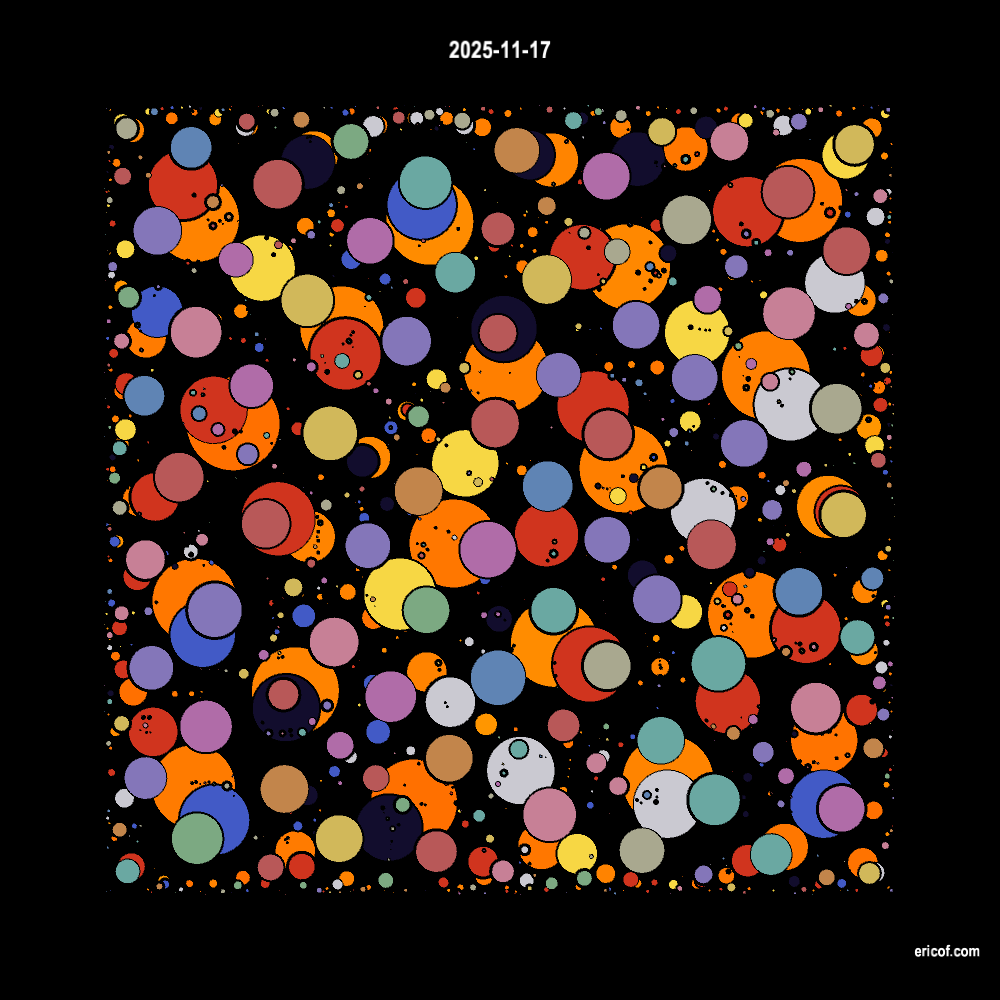"""2025-11-17
Distributing circles 03
Exercício de distribuição de círculos dentro de um círculo maior.
ericof.com
png
Sketch,py5,CreativeCoding
"""
from collections import deque
from sketches.utils.draw import canvas
from sketches.utils.draw.cores.paletas import gera_paleta
from sketches.utils.helpers import sketches as helpers
import numpy as np
import py5
sketch = helpers.info_for_sketch(__file__, __doc__)
class Circle:
"""A little class representing an SVG circle."""
def __init__(self, cx, cy, r, color=None):
"""Initialize the circle with its centre, (cx,cy) and radius, r.
icolor is the index of the circle's color.
"""
self.cx, self.cy, self.r = cx, cy, r
self.color = color
def overlap_with(self, cx, cy, r):
"""Does the circle overlap with another of radius r at (cx, cy)?"""
d = np.hypot(cx - self.cx, cy - self.cy)
return d < r + self.r
class Circles:
"""A class for drawing circles-inside-a-circle."""
def __init__(
self,
colors: deque[py5.Py5Color],
width=800,
height=800,
R=400,
n=800,
rho_min=0.005,
rho_max=0.05,
guard=1000,
):
"""Initialize the Circles object.
width, height are the SVG canvas dimensions
R is the radius of the large circle within which the small circles are
to fit.
n is the maximum number of circles to pack inside the large circle.
rho_min is rmin/R, giving the minimum packing circle radius.
rho_max is rmax/R, giving the maximum packing circle radius.
colors is a list of SVG fill color specifiers to be referenced by
the class identifiers c<i>. If None, a default palette is set.
"""
self.width, self.height = width, height
self.R, self.n = R, n
# The centre of the canvas
self.CX, self.CY = self.width // 2, self.height // 2
self.rmin, self.rmax = R * rho_min, R * rho_max
self.guard = guard
self.colors = colors
self.img = np.ones((height, width))
def _circle_fits(self, icx, icy, r):
"""If I fits, I sits."""
if icx - r < 0 or icy - r < 0:
return False
if icx + r >= self.width or icy + r >= self.height:
return False
return all((
self.img[icx - r, icy],
self.img[icx + r, icy],
self.img[icx, icy - r],
self.img[icx, icy + r],
))
def apply_circle_mask(self, icx, icy, r):
"""Zero all elements of self.img in circle at (icx, icy), radius r."""
x, y = np.ogrid[0 : self.width, 0 : self.height]
r2 = (r + 1) ** 2
mask = (x - icx) ** 2 + (y - icy) ** 2 <= r2
self.img[mask] = 0
def _place_circle(self, r, c_idx=None):
"""Attempt to place a circle of radius r within the image figure.
c_idx is a list of indexes into the self.colors list, from which
the circle's colour will be chosen. If None, use all colors.
"""
if not c_idx:
c_idx = range(len(self.colors))
# Get the coordinates of all non-zero image pixels
img_coords = np.nonzero(self.img)
if not img_coords:
return False
# The guard number: if we don't place a circle within this number
# of trials, we give up.
guard = self.guard
# For this method, r must be an integer. Ensure that it's at least 1.
r = max(1, int(r))
while guard:
# Pick a random candidate pixel...
i = np.random.randint(len(img_coords[0]))
icx, icy = img_coords[0][i], img_coords[1][i]
# ... and see if the circle fits there
if self._circle_fits(icx, icy, r):
self.apply_circle_mask(icx, icy, r)
circle = Circle(icx, icy, r, color=self.colors[np.random.choice(c_idx)])
self.circles.append(circle)
return True
guard -= 1
return False
def __call__(self) -> list[Circle]:
"""Place the little circles inside the big one."""
# First choose a set of n random radii and sort them. We use
# random.random() * random.random() to favour small circles.
self.circles = []
r = self.rmin + (self.rmax - self.rmin) * np.random.random(
self.n
) * np.random.random(self.n)
r[::-1].sort()
# Do our best to place the circles, larger ones first.
for i in range(self.n):
self._place_circle(r[i])
return self.circles
def setup():
py5.size(*helpers.DIMENSOES.external, py5.P3D)
cor_fundo = py5.color("#000")
py5.background(cor_fundo)
camadas = [
(-10, gera_paleta("laranja-02", True), 500),
(-8, gera_paleta("mondrian", True), 400),
(-6, gera_paleta("pastel", True), 300),
]
for z, paleta, raio in camadas:
with py5.push():
py5.translate(*helpers.DIMENSOES.pos_interno, z)
circles = Circles(
colors=paleta,
width=800,
height=800,
R=raio,
n=2000,
guard=1100,
rho_min=0.0005,
rho_max=0.20,
)
for circle in circles():
x = circle.cx
y = circle.cy
r = circle.r
color = circle.color
with py5.push():
peso = py5.random_int(1, 3)
py5.stroke("#000")
py5.stroke_weight(peso)
py5.fill(color)
py5.circle(x, y, r)
# Credits and go
canvas.sketch_frame(
sketch, cor_fundo, "large_transparent_white", "transparent_white"
)
def key_pressed():
key = py5.key
if key == " ":
save_and_close()
def save_and_close():
py5.no_loop()
canvas.save_sketch_image(sketch)
py5.exit_sketch()
if __name__ == "__main__":
py5.run_sketch()
